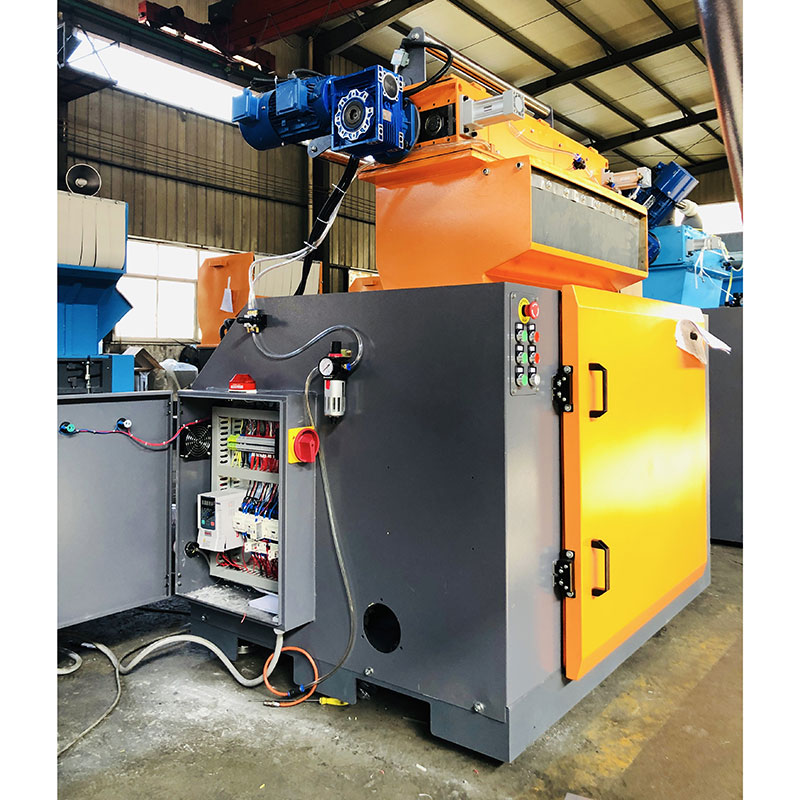Features of Thermoforming Sheet Crusher
2024-06-19
A thermoforming sheet crusher is a specialized machine used to reduce the size of thermoformed plastic sheets or parts into smaller pieces or granules. Thermoforming is a manufacturing process where plastic sheets are heated to a pliable forming temperature, formed to a specific shape in a mold, and then trimmed to create a usable product. Here’s an overview of the features, working principle, applications, and considerations related to a thermoforming sheet crusher:
Features of Thermoforming Sheet Crusher:
1. Crushing Mechanism:
- Cutting Blades: Equipped with sharp blades or knives designed to cut through thermoformed plastic sheets or parts.
- Crushing Chamber: Contains the blades and a rotating shaft to shred and reduce the size of the plastic material.
2. Material Handling:
- Feed Mechanism: Allows feeding of large thermoformed sheets or parts into the crusher for size reduction.
- Conveyor or Feed Hopper: Transports the material into the crushing chamber for processing.
3. Size Reduction:
- Output Size: Produces smaller pieces or granules of thermoformed plastic suitable for recycling or reuse.
- Adjustable Settings: Allows adjustment of blade clearance and rotor speed to control the final particle size.
4. Construction:
- Heavy-Duty Design: Constructed from durable materials such as steel to withstand the impact and stress of crushing operations.
- Safety Features: Includes safety guards, emergency stop buttons, and safety interlocks to protect operators.
5. Motor and Drive System:
- Power: Operates with a motor of sufficient power to drive the cutting blades and handle the crushing load.
- Drive System: Typically uses a belt or direct drive system for efficient power transmission.
6. Control Panel:
- User Interface: Provides controls for starting, stopping, and adjusting operational parameters of the crusher.
- Safety Controls: Includes overload protection and other safety features to prevent equipment damage and ensure operator safety.
Working Principle:
- Thermoformed plastic sheets or parts are fed into the crusher through a feed mechanism.
- The sharp blades or knives mounted on a rotating shaft inside the crushing chamber shred and cut the thermoformed plastic into smaller pieces.
- The crushed material exits the crusher through a discharge mechanism, typically into a collection bin or conveyor for further processing or recycling.
Applications of Thermoforming Sheet Crusher:
1. Plastic Recycling Facilities:
- Used to process rejected or scrap thermoformed plastic parts into recyclable material.
- Prepares thermoformed sheets for subsequent processing such as extrusion, pelletizing, or molding.
2. Manufacturing Plants:
- Supports in-house recycling efforts by reducing waste and optimizing material usage.
- Handles trim waste and rejects from thermoforming operations to minimize disposal costs.
3. Environmental Initiatives:
- Contributes to sustainability goals by recycling thermoformed plastics into reusable forms, reducing environmental impact.
Considerations:
- Material Compatibility: Ensure the crusher is suitable for the type and thickness of thermoformed plastic being processed.
- Throughput: Evaluate the crusher’s capacity to handle the required volume of thermoformed sheets or parts per hour.
- Maintenance: Regular inspection and maintenance of blades and moving parts to ensure optimal performance and longevity.
- Safety: Follow safety protocols and provide training for operators handling the thermoforming sheet crusher to prevent accidents.
Conclusion:
A thermoforming sheet crusher is a specialized machine essential for recycling and reducing thermoformed plastic sheets or parts into smaller granules or pieces. By effectively shredding and processing thermoformed plastic waste, these crushers contribute to environmental sustainability and efficient material reuse in various industries. Understanding their features, working principle, applications, and maintenance requirements helps in selecting and utilizing a thermoforming sheet crusher to meet specific recycling and processing needs effectively.



